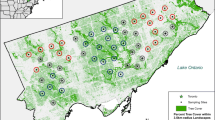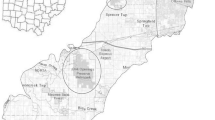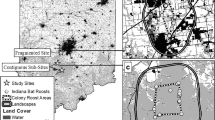Abstract
Urbanization and development are predicted to increase considerably in the United States over the next several decades, and this is expected to result in large-scale habitat loss, fragmentation and loss of wildlife species. Thus, natural parks and preserves are becomingly increasingly important in the conservation of regional biodiversity. We used mist-nets and AnabatII acoustic detectors to survey bats in 10 national parks in the southeastern U.S. and examined the relationship between bat community structure and development in the surrounding 5 km. We predicted that species richness would increase with park size and that species richness and evenness would decrease with development. Species richness was not related to development or any other landscape characteristics including park size. In contrast, species evenness declined with increasing development. Percent Developed land in the surrounding 5 km area was the only variable that entered into the stepwise regression model. The decrease in species evenness in the urban parks was due to the dominance of big brown bats (Eptesicus fuscus) in these parks. The percentage of big brown bats in our captures was positively related to percent Developed land in the surrounding area. Our data suggest that urban parks may be important for conserving regional bat biodiversity. However, the low species evenness in these parks suggests that some bat species may be susceptible to the effects of urbanization and may be extirpated over time. Thus, management of urban as well as rural parks should strive to conserve as much bat roosting and foraging habitat as possible.


Similar content being viewed by others
References
Ahlén I (1983) The bat fauna of some isolated islands in Scandinavia. Oikos 41:352–358. doi:10.2307/3544093
Alig RJ, Platinga AJ, Ahn S, Kline JD (2003) Land use changes involving forestry in the United States: 1952 to 1997, with projections to 2050. Gen. Tech. Report-587, Pacific Northwest Research Station, USDA Forest Service, Portland, OR
Alig RJ, Kline JD, Lichtenstein M (2004) Urbanization on the US landscape: looking ahead in the 21st century. Landsc Urban Plan 69:219–234. doi:10.1016/j.landurbplan.2003.07.004
Allen J, Lu K (2003) Modeling and prediction of future urban growth in the Charleston region of South Carolina: a GIS-based integrated approach. Conserv Ecol 8:2 Available online at http://www.consecol.org/vol8/iss2/art2
Avila-Flores R, Fenton MB (2005) Use of spatial features by foraging insectivorous bats in a large urban landscape. J Mammal 86:1193–1204. doi:10.1644/04-MAMM-A-085R1.1
Brigham RM, Kalko EK, Jones G, Parson S, Limpens HJGA (2004) Bat echolocation research: tools, techniques and analysis. Bat Conservation International, Austin
Britzke ER (2003) Use of ultrasonic detectors for acoustic identification and study of bat ecology in the eastern United States. PhD Dissertation. Tennessee Technological University, Cookville, TN
Britzke ER, Murray KL (2000) A quantitative method for selection of identifiable search-phase calls using the Anabat system. Bat Res News 41:33–36
Broders HG, Forbes GJ, Woodley S, Thompson ID (2006) Range extent and stand selection for roosting and foraging in forest-dwelling northern long-eared bats and little brown bats in the Greater Fundy Ecosystem, New Brunswick. J Wildl Manage 70:1174–1184. doi:10.2193/0022-541X(2006)70[1174:REASSF]2.0.CO;2
Czech B, Krausman PR, Devers PK (2000) Economic associations among causes of species endangerment in the United States. Bioscience 50:593–601. doi:10.1641/0006-3568(2000)050[0593:EAACOS]2.0.CO;2
Duchamp JE, Sparks DW, Whitaker JO Jr (2004) Foraging-habitat selection by bats at an urban–rural interface: comparison between a successful and a less successful species. Can J Zool 82:1157–1164. doi:10.1139/z04-095
Elmore LW, Miller DA, Vilella FJ (2005) Foraging area size and habitat use by red bats (Lasiurus borealis) in an intensively managed pine landscape in Mississippi. Am Midl Nat 153:405–417. doi:10.1674/0003-0031(2005)153[0405:FASAHU]2.0.CO;2
Estrada A, Coates-Estrada R, Meritt D Jr (1993) Bat species richness and abundance in tropical rain forest fragments and in agricultural habitats at Los Tuxtlas, Mexico. Ecography 16:309–318. doi:10.1111/j.1600-0587.1993.tb00220.x
Everette AL, O’Shea TJ, Ellison LE, Stone LA, McCance JL (2001) Bat use of a high-plains urban wildlife refuge. Wildl Soc Bull 29:967–973
Falkner MB, Stohlgren TJ (1997) Evaluating the contribution of small National Park areas to regional biodiversity. Nat Areas J 17:324–330
Ferguson HL, Robinette K, Stenberg K (2001) Wildlife of urban habitats. In: Johnson DH, O’Neil TA (eds) Wildlife–habitat relationships in Oregon and Washington. Oregon State University Press, Corvallis, pp 317–341
Gaisler J, Zukal J, Rehak Z, Homolka M (1998) Habitat preference and flight activity of bats in a city. J Zool (Lond) 244:439–445. doi:10.1111/j.1469-7998.1998.tb00048.x
Geggie JF, Fenton MG (1985) A comparison of foraging by Eptesicus fuscus (Chiroptera: Vespertilionidae) in urban and rural environments. Can J Zool 63:263–267
Gehrt SD, Chelsvig JE (2003) Bat activity in an urban landscape: patterns at the landscape and microhabitat scale. Ecol Appl 13:939–950. doi:10.1890/02-5188
Hayes JP (2000) Assumptions and practical considerations in the design and interpretation of echolocation-monitoring studies. Acta Chiropt 2:225–236
Hickey MBC, Acharya L, Pennington S (1996) Resource partitioning by two species of vespertilionid bats (Lasiurus cinereus and Lasiurus borealis) feeding around street lights. J Mammal 77:325–334. doi:10.2307/1382804
Homer C, Huang C, Yang L, Wylie B, Coan M (2004) Development of a 2001 national land cover database for the United States. Photogramm Eng Remote Sensing 70:829–840
Hourigan CL, Johnson C, Robson SKA (2006) The structure of a micro-bat community in relation to gradients of environmental variation in a tropical urban area. Urban Ecosyst 9:67–82. doi:10.1007/s11252-006-7902-4
Huang C, Yang L, Wylie B, Homer C (2001) A strategy for estimating tree canopy density using Landsat 7 ETM+ and high resolution images over large areas. In: Third International Conference on Geospatial Information in Agriculture and Forestry; November 5–7, 2001; Denver, Colorado. CD-ROM, 1 disk
Johnson JB, Gates JE, Ford WM (2008) Distribution and activity of bats at local and landscape scales within a rural–urban gradient. Urban Ecosyst 11:227–242. doi:10.1007/s11252-008-0055-x
Kalcounis-Rueppell MC, Payne VH, Huff SR, Boyko AL (2007) Effects of wastewater treatment plant effluent on bat foraging ecology in an urban stream system. Biol Conserv 138:120–130. doi:10.1016/j.biocon.2007.04.009
Kunz TH, Kurta A (1988) Capture methods and holding devises. In: Kunz TH (ed) Ecological and behavioral methods for the study of bats. Smithsonian Institution Press, Washington, DC, pp 1–29
Kurta A, Teramino JA (1992) Bat community structure in an urban park. Ecography 15:257–261. doi:10.1111/j.1600-0587.1992.tb00032.x
Lesiński G, Kowalski M, Wojtowicz B, Gulatowska J, Lisowska A (2007) Bats on forest islands of different size in an agricultural landscape. Folia Zool (Brno) 56:153–161
Lodé T (2000) Effect of a motorway on mortality and isolation of wildlife populations. Ambio 29:163–166. doi:10.1639/0044-7447(2000)029[0163:EOAMOM]2.0.CO;2
Mager KJ, Nelson TA (2001) Roost-site selection by eastern red bats (Lasiurus borealis). Am Midl Nat 145:120–126. doi:10.1674/0003-0031(2001)145[0120:RSSBER]2.0.CO;2
Magurran AE (2004) Measuring biological diversity. Blackwell, Oxford
Marzluff JM (2005) Island biogeography for an urbanizing world: how extinction and colonization may determine biological diversity in human-dominated landscapes. Urban Ecosyst 8:157–177. doi:10.1007/s11252-005-4378-6
McIntyre NE (2000) Ecology of urban arthropods: a review and a call to action. Ann Entomol Soc Am 93:825–835. doi:10.1603/0013-8746(2000)093[0825:EOUAAR]2.0.CO;2
McKinney ML (2002) Urbanization, biodiversity, and conservation. Bioscience 52:883–890. doi:10.1641/0006-3568(2002)052[0883:UBAC]2.0.CO;2
McKinney ML (2008) Effects of urbanization on species richness: a review of plants and animals. Urban Ecosyst 11:161–176. doi:10.1007/s11252-007-0045-4
Menzel MA, Chapman BR, Ford WM, Menzel JM, Laerm J (2000) A review of the distribution and roosting ecology of bats in Georgia. Ga J Sci 58:143–178
Menzel MA, Menzel JM, Ford WM, Edwards JW, Carter TC, Churchill JB et al (2001) Home range and habitat use of male Rafinesque’s big-eared bats (Corynorhinus rafinesquii). Am Midl Nat 145:402–408. doi:10.1674/0003-0031(2001)145[0402:HRAHUO]2.0.CO;2
Menzel JM, Menzel MA, Ford WM, Edwards JW, Sheffield SR, Kilgo JC et al (2003) The distribution of the bats of South Carolina. Southeast Nat 2:121–152. doi:10.1656/1528-7092(2003)002[0121:TDOTBO]2.0.CO;2
Mickleburgh SP, Hutson AM, Racey PA (2002) A review of the global conservation status of bats. Oryx 36:18–34
Miller DA, Arnett EB, Lacki MJ (2003) Habitat management for forest-roosting bats of North America: a critical review of habitat studies. Wildl Soc Bull 31:30–44
Montiel S, Estrada A, León P (2006) Bat assemblages in a naturally fragmented ecosystem in the Yucatan Peninsula, Mexico: species richness, diversity and spatio-temporal dynamics. J Trop Ecol 22:267–276. doi:10.1017/S026646740500307X
NatureServe (2007) NatureServe Explorer: An online encyclopedia of life [web application]. Version 6.2. NatureServe, Arlington, Virginia. Available at http://www.natureserve.org/explorer. Accessed: October 21, 2007
Neubaum DJ, Wilson KR, O’Shea TJ (2007) Urban maternity-roost selection by big brown bats in Colorado. J Wildl Manage 71:728–736. doi:10.2193/2005-684
Nichols B, Jenkins M, Rock J, Langdon K, Leibfreid T (2000) Study plan for vertebrate and vascular plant inventories in Cumberland Piedmont and Appalachian Highlands Networks. National Park Service
Noss RF, Cooperrider AY (1994) Saving nature’s legacy: protecting and restoring biodiversity. Island, Washington DC
O’Farrell MJ, Miller BW, Gannon WL (1999) Qualitative identification of free-flying bats using the Anabat detector. J Mammal 80:11–23. doi:10.2307/1383203
Pedersen SC, Genoways HH, Morton MN, Johnson JW, Courts SE (2003) Bats of Nevis, northern Lesser Antilles. Acta Chiropt 5:251–267
Racey PA, Entwistle AC (2003) Conservation ecology of bats. In: Kunz TH, Fenton MB (eds) Bat ecology. University of Chicago Press, Chicago, pp 680–743
Reddy E, Fenton FB (2003) Exploiting vulnerable prey: moths and red bats (Lasiurus borealis; Vespertilionidae). Can J Zool 81:1553–1560. doi:10.1139/z03-146
Ricklefs RE, Lovette IJ (1999) The roles of island area per se and habitat diversity in the species–area relationships of four Lesser Antillean faunal groups. J Anim Ecol 68:1142–1160. doi:10.1046/j.1365-2656.1999.00358.x
SAS Institute (2002) SAS/STAT user’s guide. Version 9. SAS Institute, Cary
Sparks DW, Laborda JA, Whitaker JO Jr (1998) Bats of the Indianapolis International Airport as compared to a more rural community of bats at Prairie Creek. Proc Indiana Acad Sci 107:171–179
Sparks DW, Ritzi CM, Duchamp JE, Whitaker JO Jr (2005) Foraging habitat of Indiana myotis (Myotis sodalis) at an urban/rural interface. J Mammal 86:713–718. doi:10.1644/1545-1542(2005)086[0713:FHOTIB]2.0.CO;2
Speakman JR, Thomas DW (2003) Physiological ecology and energetics of bats. In: Kunz TH, Fenton MB (eds) Bat ecology. University of Chicago Press, Chicago, pp 209–253
Thayer JD (2002) Stepwise regression as an exploratory data analysis procedure. Presented at the Annual Meeting of the American Educational Research Association, April 2, 2002, New Orleans, Louisiana. 11 pp
Tuberville TD, Willson JD, Dorcas ME, Gibbons JW (2005) Herpetofaunal species richness of southeastern national parks. Southeast Nat 4:537–569. doi:10.1656/1528-7092(2005)004[0537:HSROSN]2.0.CO;2
Ulrey WA, Sparks DW, Ritzi CM (2005) Bat communities in highly impacted areas: comparing Camp Atterbury to the Indianapolis Airport. Proc Indiana Acad Sci 114:73–76
van der Ree R, McCarthy MA (2005) Inferring persistence of indigenous mammals in response to urbanisation. Anim Conserv 8:308–319
Walters BL, Ritzi CM, Sparks DW, Whitaker JO Jr (2007) Foraging behavior of eastern red bats (Lasiurus borealis) at an urban–rural interface. Am Midl Nat 157:365–373. doi:10.1674/0003-0031(2007)157[365:FBOERB]2.0.CO;2
Wear DN, Greis JG (2002) Southern forest resource assessment. Gen Tech Report-53, USDA, Forest Service, Southern Research Station, Asheville, NC
Weller TJ, Zabel CJ (2002) Variation in bat detections due to detector orientation in a forest. Wildl Soc Bull 30:922–930
Whitaker JO Jr, Brack V Jr, Cope JB (2002) Are bats in Indiana declining. Proc Indiana Acad Sci 111:95–106
Wilcove DS, Rothstein D, Dubow J, Phillips A, Losos E (1998) Quantifying threats to imperiled species in the United States. Bioscience 48:607–615. doi:10.2307/1313420
Wilkins KT (1989) Tadarida brasiliensis. Mamm Species 331:1–10. doi:10.2307/3504148
Acknowledgements
Funding for this project was provided by the National Park Service, Southeast Coast Inventory and Monitoring Network and the Cumberland Piedmont Inventory and Monitoring Network. We thank C. A. Dachelet, S. Buranek, J. Fernandez, L. Staples, T. Torongeau, and K. Wolcott for assistance in the field and personnel at all of the parks for logistical support. We thank P. G. R. Jodice, J. M. O’Keefe, D. W. Sparks, S. J. Zarnoch and two anonymous reviewers for helpful comments on previous drafts of the manuscript.
Author information
Authors and Affiliations
Corresponding author
Appendix
Appendix
Rights and permissions
About this article
Cite this article
Loeb, S.C., Post, C.J. & Hall, S.T. Relationship between urbanization and bat community structure in national parks of the southeastern U.S.. Urban Ecosyst 12, 197–214 (2009). https://doi.org/10.1007/s11252-008-0075-6
Published:
Issue Date:
DOI: https://doi.org/10.1007/s11252-008-0075-6




